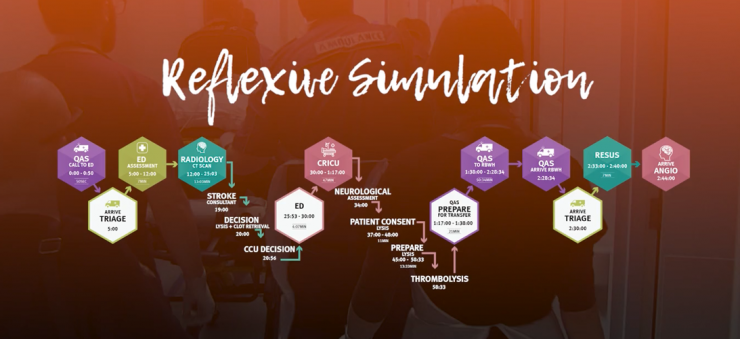Reflexive simulation is all about understanding how work is done. It is the sociology of knowledge that refers to the circular relationships between cause and effect.
An improvement tool
This new quality improvement tool, combines traditional uses of simulation with a systems and safety improvement methodology. Identifying the systemic causes to develop innovative solutions to tackle the wicked problems in healthcare.
By using a reflexive approach, we engage the front-line through a sensemaking and co-design process to develop a shared understanding. Essential to reflexive simulation is the capturing of real situations, events and patient experiences.
Incorporating systems thinking, human factors, resilience engineering, video-reflexive-ethnography, facilitation and simulation – reflexive simulation complements traditional quality improvement programs with contemporary science.
Acute stroke patient’s journey
Several months ago CSDS and Metro North HHS – Medicine Stream, collaborated to implement a reflexive simulation of an acute stroke patient’s journey. It engaged hundreds of staff across MNHHS (RBWH, Caboolture and QAS) in this new methodology of quality improvement.
Over a 12 week period, front-line staff were involved in a variety of sense-making and co-design activities that helped create a world first live streamed simulation event capturing an acute stroke patient’s journey. The data collected has been incorporated into a comprehensive report that will help form the Metro North HHS stroke guidelines.
Outcomes
Notable outcomes from the exercise include self-identification from the pharmaceutical industry on the need to develop a more efficient method of thrombolysis delivery; the connections built between hospital departments; the role of the QAS when transferring an acute stroke patient between MNHHS hospitals; obtaining consent for lysis/ECR of an acutely ill patient; and implementation of the ‘grey blanket’ protocol.
At a departmental level we have seen the true value of reflexive simulation, where local improvement methodologies are evolving to create new and practical solutions for staff. The engagement and leadership at the front-line actively drives quality improvement initiatives to think and imagine how to do healthcare differently.
What’s next
To grow and build this capability, CSDS in collaboration with the Clinical Excellence Division (CED) have developed a comprehensive improvement framework. Where leaders, facilitators, educators and clinicians can share, learn and journey through an individualised improvement pathway.
If you are interested in finding out more about our initiatives and how you could join and be part of this exciting movement, please contact us.










